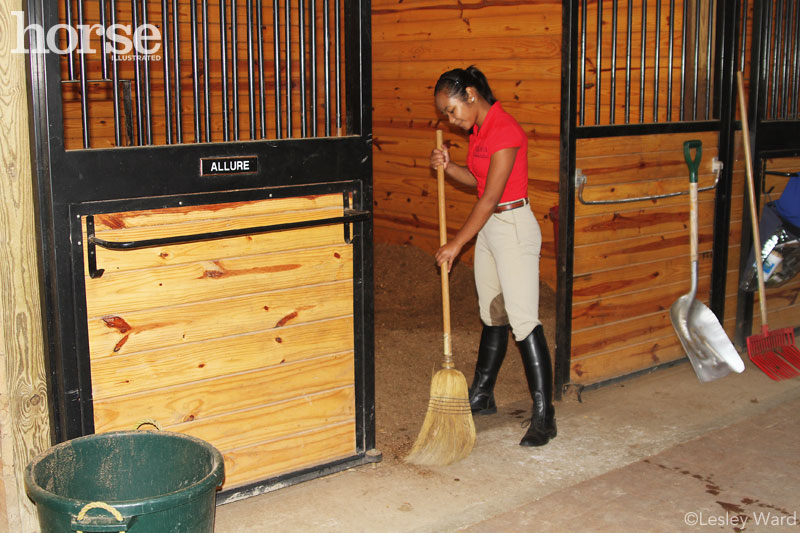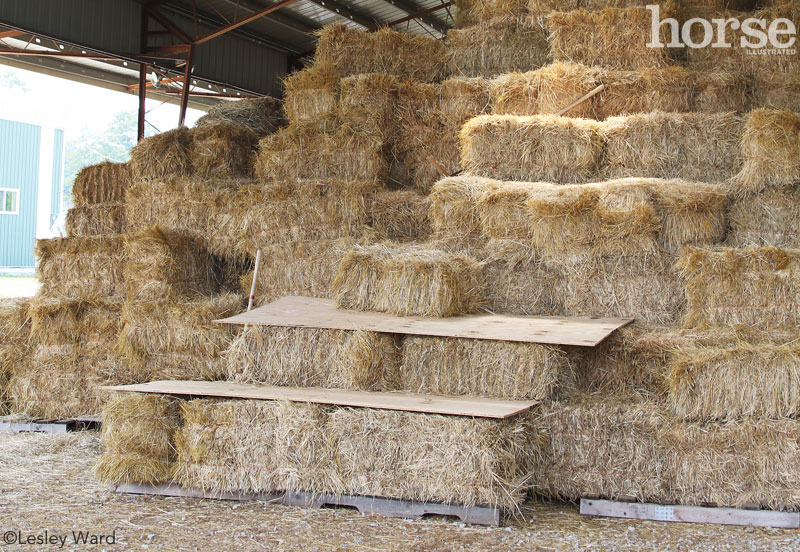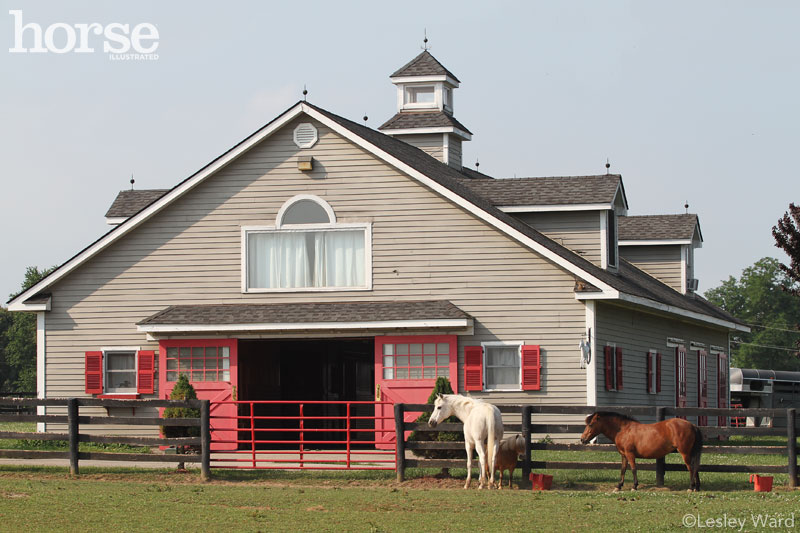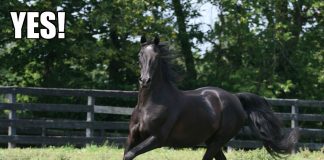A barn is basically a fire waiting to happen. Full of hay, straw, shavings and other flammable materials, all it takes is the smallest spark to ignite. Because the risk is so high, it’s important to be proactive about fire prevention.
But, as Loveman acknowledges, we don’t live in an ideal world and our barns most often are not designed as we would like them to be. Keeping that in mind, here are some simple things you can do to help prevent fire in your barn.
- Enforce a strict “no smoking” rule in the barn.
- Keep it clean! According to Loveman, a broom and a rake are the two best fire prevention tools a horse owner can have.
- Knock down cobwebs; they create pathways for fire to spread.
- Sweep up loose hay, bedding and debris that could ignite or spread flames.
- Keep grass, shrubs, trees, brush and other landscaping around the barn trimmed and mowed to provide a fire break around your barn and property.
- Keep barn aisleways and exits clear at all times.
- Tractors and other gas-powered vehicles and equipment should be stored outside the barn because the electrical, fuel and exhaust systems can cause fires. Loveman recommends 50 feet from any barn with horses inside.
- Gas and other flammable solvents should not be stored in or near the barn. Fuel up machinery from a safe distance outside as well—gas vapors are highly flammable.
- Keep hay and bedding in a separate building or storage area if possible. Hay is not only fuel for a fire; there is also a risk of spontaneous combustion from hay that was not properly dried before it was baled.
- Don’t abuse extension cords. Make sure any cords you use around the barn are for outdoor, heavy-duty use. Outdoor extension cords have a thicker cover to insulate and protect the conducting wires inside. They are also designed to withstand temperature fluctuations, moisture and other outdoor conditions. Using an indoor extension cord can lead to overheating and short circuits.
- Inspect all electrical cords for fraying and damage. Do not use worn or damaged cords.
- Avoid stringing multiple extension cords together, or overloading an extension cord with more watts than it is rated to handle. Also remember that using a longer cord can reduce its carrying power.
- Keep all electrical cords out of horses’ reach so they don’t chew on them. Cords should also be kept off the ground where people or horses can’t step on them.
- Call in a professional when it comes to the electrical system in your barn. Have a licensed electrician perform any electrical work in the barn and inspect existing electrical for safety.
- Wiring should all be encased in conduit (metal or PVC) to keep rodents and other critters from chewing on it. If your barn has any exposed wiring, this is a danger that needs to be corrected immediately.
- Remove dust, debris and cobwebs from around electrical outlets; install weatherproof covers if possible to keep them clean.
- Turn off and unplug appliances not in use, including clippers and radios. Also unplug extension cords that aren’t being used.
- Clean electrical appliances used in the barn, such as fans, every few months. Unplug them and use compressed air to blow away dirt and grime.
- Avoid using space heaters and heat lamps in a barn. Even under supervision, these items are particularly risky.
- Opinions vary on the 5-gallon heated water buckets that many horse owners rely on throughout the winter. The buckets are designed to run continuously while plugged in, but if the bucket is empty, the heater could potentially melt the plastic and start a fire in the stall. However, according to the experts commenting at www.firesafetyinbarns.com, the risk should be relatively small due to the buckets’ low wattage. “Cords must be attached in such a way that the stall occupant cannot have access to them,” says Loveman.
- For automatic waterers with an electric heater, select one that is approved by the major product safety agencies, such as Underwriters Laboratory (UL) and the CSA, and make sure to follow the manufacturer’s instructions. Use a licensed electrician for installation.
- To minimize the risk of fire from a lightning strike, buildings on your farm should be equipped with lightning rods. To ensure that your lightning protection system is properly grounded, it must be installed by a certified professional. (To find a professional installer or verify credentials, contact the Lightning Protection Institute; www.lightning.org.)
- Each occupied stall should have a halter and lead rope hanging by the door. A barn fire may leave very little time to evacuate, and you don’t want to waste precious minutes hunting for a halter. Leather halters with cotton leads are best, since nylon is prone to melting when exposed to the extreme heat of a fire. Consider keeping extra halters and lead ropes in a convenient location, too.
- Barn and stall doors and latches should open easily and efficiently, facilitating everyday horse handling and chores, as well as enabling you to get horses out quickly during an evacuation.
- Every barn should have fire extinguishers. A multipurpose extinguisher (rated ABC) is the type recommended for stables. Mount extinguishers at each entrance, and every 30 to 40 feet throughout the barn for larger facilities.
- Inspect fire extinguishers once a month to make sure they are accessible, in good condition, and ready to operate. Check the gauge to make sure pressure is at the recommended level, and follow maintenance instructions in the owner’s manual. Replace an extinguisher immediately if it’s damaged or in need of recharging. Also learn how to operate your extinguisher properly.
- Make sure the entrance to your property is clearly marked from the road so that emergency responders can find it easily. Also ensure that your property and barn are accessible to fire trucks and other large emergency vehicles.
- Post a sign prominently with emergency instructions. This should include the numbers to call (911 or emergency services for your area), the address for the property, and any directions needed to help find it. (Click here to download one for your barn.)
- Contact your local fire department for advice on barn fire prevention. Even better, invite them to visit your property so they will be familiar with the layout and can offer specific recommendations to improve fire safety.
- Have an evacuation plan in place for your barn, and make sure everyone knows what to do.



In Case of Fire:
Keep calm, take a moment to assess the situation and get to a safe place if needed. Then, focus on the following steps:
- Call 911 or the fire department.
- Say, “I have a horse stable fire at (your address).” This lets emergency personnel know it is a barn with live animals, not just a storage barn.
- Get people out of the barn first.
- Begin evacuating horses only if it is safe to do so without endangering human life.
- Remove one horse at a time, as quickly and calmly as you can. It’s usually best to start with the horse closest to the exit.
- Do not turn horses loose; they may try to return to the barn.
- Blindfold horses only if necessary.
- Evacuate horses to a pre-determined pasture, paddock or other secure location on the property that can be reached quickly, but is out of the danger zone.
- Follow instructions from the fire department or emergency personnel.
Fire Safety Resources for Horse Owners:
- www.firesafetyinbarns.com
- www.humanesociety.org/assets/pdfs/Horse-Barn-Fire-Publication.pdf
- Lightning Protection Institute; www.lightning.org
This article originally appeared in the September 2014 issue of Horse Illustrated magazine. Click here to subscribe!







I am a life-safety & protection systems consultant and fire investigator with over 40 years experience as well as almost 50 years riding the fire trucks. Great to see that you recommend fire sprinkler systems and this is the #1 method of protection if prevention fails, but there was NO mention of the #2 method, which is much easier & more economical than fire sprinklers. An early warning fire detection system that is central station monitored is critical to at least getting the fire department on the road early enough to possibly do some good as well as alarm and alert locally so that the horses may be removed from the barn and extinguishers used to slow down the fire. This is a critical step in the overall protection plan. The syetm should be designed & installed professionally in accordance with NFPA Standard #72.
Good advise.